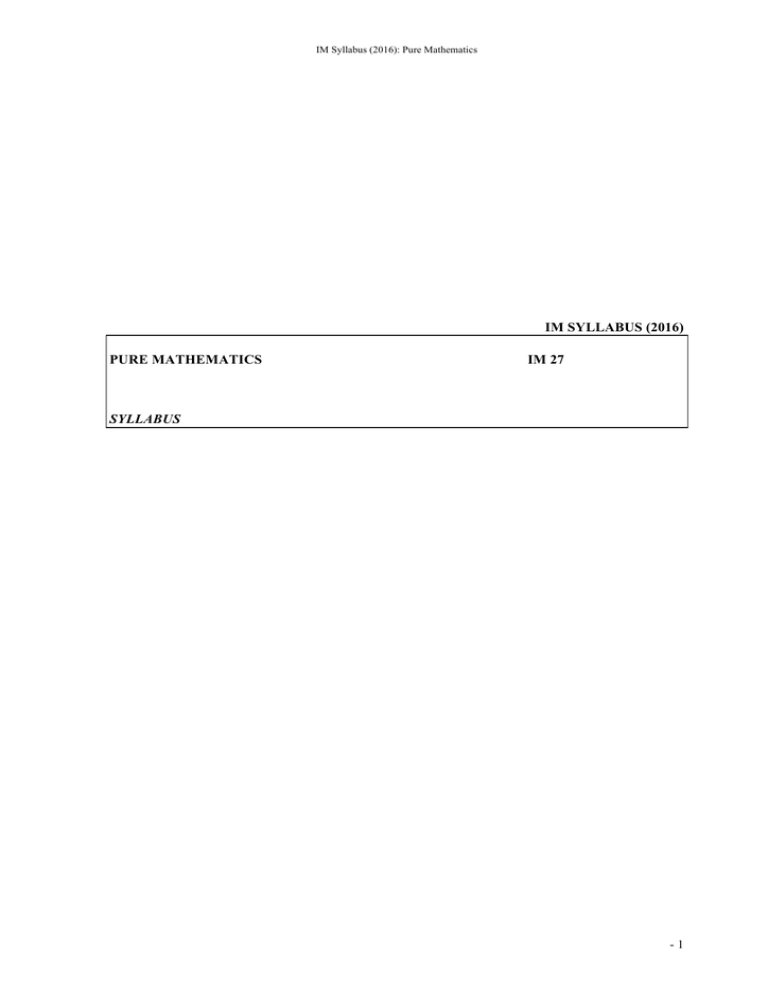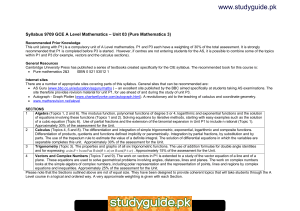SYLLABUS IM SYLLABUS (2016) PURE MATHEMATICS
advertisement

IM Syllabus (2016): Pure Mathematics IM SYLLABUS (2016) PURE MATHEMATICS IM 27 SYLLABUS -1 IM Syllabus (2016): Pure Mathematics Pure Mathematics Syllabus IM 27 (Available in September) 1 Paper (3 hrs) 1. Aims: • To encourage confidence, enjoyment and satisfaction through the development and use of Mathematics. • To develop an awareness of the relevance of Mathematics to other fields of study and of work. • To be able to formulate a mathematical representation of a real life situation. • To use appropriate technology such as computers and calculators as a mathematical tool. • To develop abilities to reason logically and to construct mathematical proofs. The syllabus assumes a good knowledge of the subject at SEC level and coverage of the extension topics in Paper 2A. It aims to consolidate this knowledge and to extend it to include more advanced concepts. Most of these new concepts are inclined to provide a general and coherent view of the subject but they will not be treated with the same rigour and at the same depth as in the Advanced level course in the subject. 2. Assessment objectives: • • • To demonstrate the understanding of mathematical concepts, theories and techniques To recognise and apply standard models in different contexts. To use calculator technology and formulae booklets efficiently. 3. Scheme of Assessment: There will be one examination paper of three hours. The paper will contain questions of possibly varying difficulty. Marks allotted to each question will be shown. No question should carry more than 15 marks. Ten questions will be set and candidates will have to answer all the questions. The total number of marks will be 100. Any examination question can contain material on more than one topic. Graphical calculators will not be allowed however scientific calculators could be used but all necessary working must be shown. A booklet with mathematical formulae will be provided. 4. Grade Description: Grade A • Candidates who are able to recall and select almost all concepts and techniques required in various contexts. • Candidates who derive results to a high degree of accuracy. • Candidates who can use mathematical language correctly and able to proceed logically in the solution of almost all of the set problems. Grade C • Candidates who are able to recall and select most of the concepts and techniques required in various contexts. • Candidates who derive results to an appropriate degree of accuracy. • Candidates who can use mathematical language correctly and able to proceed logically in the solution of most of the set problems. -2 IM Syllabus (2016): Pure Mathematics Grade E • Candidates who are able to recall and select some of the concepts and techniques required in various contexts. • Candidates who derive results to an acceptable degree of accuracy. • Candidates who can use mathematical language correctly and able to proceed logically in the solution of a fair number of the set problems 5. Subject content: The topics in the syllabus are not arranged in teaching order. The syllabus is not meant as a teaching scheme and teachers are free to adopt a teaching sequence that they deem to be suitable for their students. Topics 1. Notes Surds, Indices and Logarithms Classification of numbers: ℝ, ℕ, ℚ 𝑎𝑛𝑑 ℤ. Use and manipulation of surds. Positive and negative rational indices To include simplification and rationalisation of the denominator of a fraction e.g. 15 − 4 27; ! !!! ! ! !!! ! Properties of indices i.e. zero, negative and fractional. The laws of indices Powers of products and quotients !! ! !!! !! . Simplifying expressions e.g. !! Solution of simple equations involving indices Logarithms Definition of logarithms, the laws of logarithms. Common and natural logarithms. Solution of simple equations involving logarithms that are of the form apx+ q = b. Problems involving change of base formula will not be set. 2. Functions Exponential and Logarithmic Functions Functions Include: • Concepts of function, domain and range • One – one and many – one functions • Use of notations e.g. 𝑓 𝑥 ≡ 𝑥 ! + 3, -3 IM Syllabus (2016): Pure Mathematics The exponential and logarithmic functions 3. Polynomials, rational functions, Remainder and factor theorem and Partial Fractions Rational functions The domain and range of these functions and their graphs Simplification of rational expressions including factorising and cancelling. Remainder and factor theorem Dividing cubic expressions Finding the remainder and also factorizing cubic expressions. Partial Fractions Include cases where the denominator is of the form: − (𝑎𝑥 + 𝑏)(𝑐𝑥 + 𝑑) − (𝑎𝑥 + 𝑏) 𝑐𝑥 + 𝑑 ! − (𝑎𝑥 + 𝑏)(𝑐𝑥 ! + 𝑑𝑥 + 𝑒) Include improper fractions In these cases the degree of the denominator must not be greater than three. 4. Quadratic Equations • • • Solution of quadratic equations by factorizing, using the formula or by completing the square. Locating the maximum or minimum value of a quadratic function. Sketching quadratic functions. Nature of roots of a quadratic equation. Knowledge of the relation between the roots 𝛼 and 𝛽 and the coefficients of a quadratic equation. Forming new equations with roots related to the original. Calculations of expressions ! ! up to the second degree such as 𝛼 ! + 𝛽 ! , ! + ! Problems involving the expression 𝛼 ! + 𝛽 ! will not be set 5. Sequences and Series Arithmetic and Geometric series Pascal’s triangle and the binomial expansion for positive integral indices Include: • Definition of a sequence and a series • The general term of an A.P. and a G.P. • The sum of an A.P. and a G.P. • Arithmetic and Geometric mean n • Use of notation and r • The sum to infinity of a geometric series Expansion of 𝑎 + 𝑏𝑥 ! for any positive integral values of n in either ascending or descending powers of x -4 IM Syllabus (2016): Pure Mathematics 6. Permutations, Combinations and Probability Permutations and Combinations Include: • Addition and multiplication principles for counting • Concepts of permutation and combination • Arrangements of objects in a line • Simple cases involving repetition and restriction Probability Definition of probability. Calculating probabilities arising from simple problems of enumeration of equally likely possibilities. Using P(A' ) = 1 – P(A) and P(A ∪ 𝐵) = P(A) + P(B) – P (A ∩ 𝐵) Use of Tree and Venn diagrams Sampling with or without replacement Candidates are expected to understand set notation 7. Straight line and linear laws Straight line Include: • Distance between two points • Mid-point of the line joining two points • Various forms of equation of a line • Condition for parallel and perpendicular lines • Intersection of two lines • Perpendicular distance from a point to a line • Intersection between a line and a curve Reduction of a relation to linear form and graphical determination of the constants Relations will be limited only to equations of the form: • y = abx • y = axb ! ! ! • = + ! 8. ! ! Trigonometric Functions and Radian measure Arc length, area of sector and area of a segment The six trigonometric functions Use of the formulae: 𝑠 = 𝑟𝜃, 𝐴 = !!𝑟 ! 𝜃, ! ! Area of segment = !𝑟 ! 𝜃 − !𝑟 ! 𝑠𝑖𝑛 𝜃 Include: • Angles can be expressed in either degree or radian measure • The graphs of sin 𝑛𝑥, a cos 𝑥 or tan 𝑥 + α , where n is a positive integer -5 IM Syllabus (2016): Pure Mathematics • The CAST Rule Graphs of sec 𝑥, cot 𝑥 and cosec 𝑥 are not required. Inverse trigonometric functions are not required. Trigonometric Identities Include Fundamental and Pythagorean identities i.e. sin 𝜃 1 tan 𝜃 ≡ , cot 𝜃 ≡ cos θ tan 𝜃 sin! 𝜃 + cos ! 𝜃 ≡ 1 tan! 𝜃 + 1 ≡ sec ! 𝜃 1 + cot ! 𝜃 ≡ cosec ! 𝜃 Solutions of simple trigonometric equations Include the trigonometric equations of the form: • 𝑎 sin 𝑥 + α = 𝑐 • 𝑎 cos 𝑛𝑥 = 𝑐, where n = 1, 2 or 3 only • Quadratic trigonometric equations ! Knowledge of the values of cosine, sine and tangent of , ! where k =1, 2, 3, 4, 6 in surd or rational form General solutions are not required 9. Curve sketching and inequalities Curve sketching and transformations Include: • Curve sketching will be limited to quadratics and cubics • Effect of the simple transformations on the graph of 𝑦 = 𝑓 (𝑥) as represented by 𝑦 = 𝑓 (𝑥 + 𝑎), 𝑦 = 𝑓 𝑥 + 𝑎, 𝑦 = 𝑓 𝑎𝑥 , 𝑦 = 𝑎𝑓 (𝑥) for a > 0, 𝑦 = 𝑓 (−𝑥) and 𝑦 = −𝑓 (𝑥). • Transformations of exponential, logarithmic, trigonometric and polynomial functions such as e!! , ln 𝑥 + 1 , − cos 𝑥 etc. Combinations of transformations are not required. Inequalities Graphical or algebraic solution of: • Linear inequality • Quadratic inequality • Cubic inequalities of the form 𝑥−𝑎 𝑥−𝑏 𝑥−𝑐 >0 !!! • Rational inequality of the form >𝑐 !!! 10. Differentiation Definition of the derivative as a limit A rigorous treatment is not expected Differentiation of simple functions Differentiation of algebraic, trigonometric, exponential and logarithmic functions -6 IM Syllabus (2016): Pure Mathematics Differentiation of implicit and parametric functions are not required Differentiation Rules Differentiation of sums, products and quotients The chain rule Applications of Differentiation Include: • Finding the gradient of a curve • Finding the equations of tangents and normals • Finding nature of stationary points and curve sketching • Application of maximum or minimum to simple practical problems • Rates of change – problems involving the chain rule of the type 11. !! !! = !! !! × !! !! may be set Integration Integration as the limit of a sum and as the inverse of differentiation A rigorous treatment is not expected Integration of simple functions Integration of algebraic, trigonometric and exponential functions i.e. xn, x– 1, (ax + b)– 1 , ekx, 𝑠𝑖𝑛 𝑘𝑥 and 𝑐𝑜𝑠 𝑘𝑥 Integration Rules The evaluation of integrals by means of: • Standard forms • Partial fractions • Using the result dx = ln f (x) + c ∫ ff '(x) (x) Exclude integration by substitution and by parts 12. Applications of Integration Definite integrals Include finding the area of the region: • Between two curves • Between a line and a curve Differential Equations First order differential equations of the separable type Exclude problems involving the formation of a differential equation 13. Matrices The algebra of matrices Include: • Definition of a matrix • Special types of matrices i.e. zero, identity and square matrices • Addition, subtraction and multiplication -7 IM Syllabus (2016): Pure Mathematics • Inverse of 2×2 matrices Exclude finding the inverse of 3×3 matrices, but students should be able to verify that two given 3×3 matrices are inverses of each other. Matrix Properties Non commutativity of multiplication Distributivity of multiplication over addition Associativity Linear transformations in the plane Finding the matrix associated with a linear transformation and vice-versa. Candidates are expected to find the matrices associated with these transformations: • Rotation through multiples of 900 about the origin • Reflections in the lines x = 0, y = 0, y = x and y=–x • Magnification. -8

